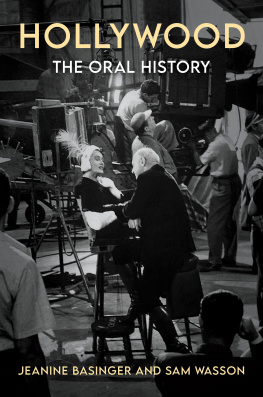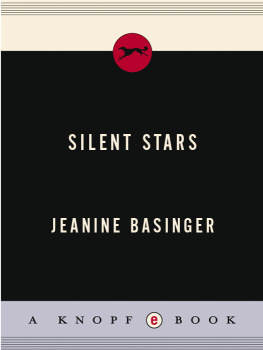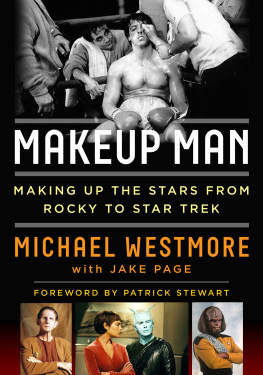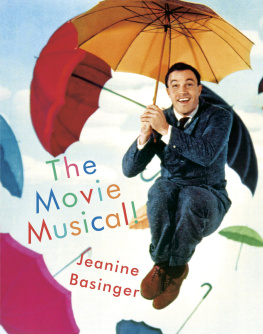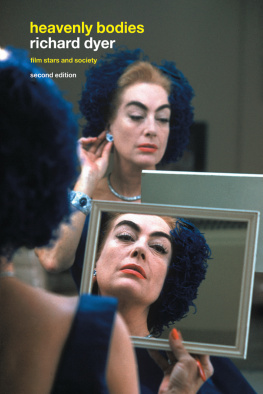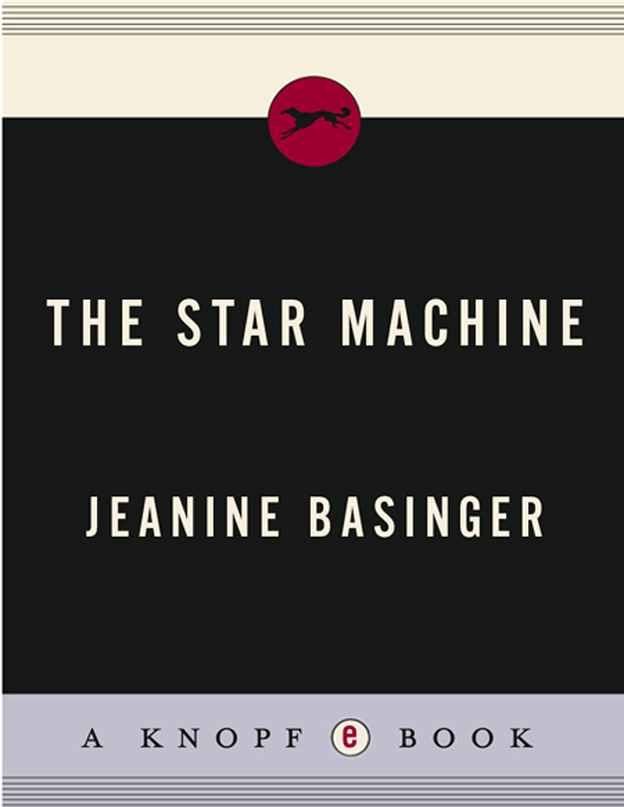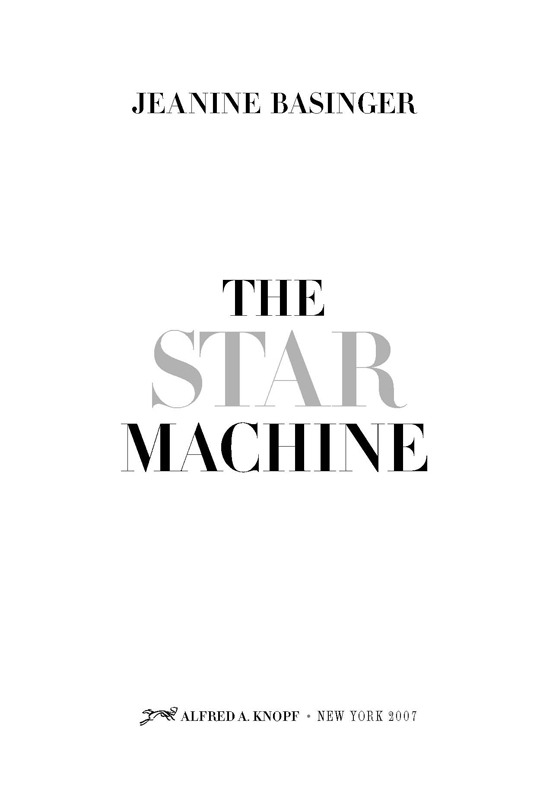ACKNOWLEDGMENTS
I am grateful to many people who were willing to sit around talking with me about movie stars, star personae, Hollywood and the studio system, et cetera, among them Jeffrey Lane, Richard Schickel, Leonard Maltin, Alexander Payne, Joss Whedon, Miguel Arteta, Ed Decter, David Kendall, Matthew Greenfield, Paul Weitz, Sammy Wasson, Dan Janvey, Domenica Cameron-Scorsese, and many more who will wonder why their names arent here. I am also deeply indebted to those who helped with photo research: Jeremy Arnold (who was imaginative and intrepid and invaluable), Ron and Howard Mandelbaum at Photofest, who have been my friends and researchers on all my books. I cannot imagine doing a film book without Photofest. I especially want to thank Maxine Fleckner Ducey, who is outstanding in her knowledge of film history and her research efforts on behalf of film scholars. Maxine and the staff of the Wisconsin Center for Film and Theater Research are reliable and cooperative, and I want to recommend that anyone looking for movie photos consider their facilities. They have an amazing collection of material that is largely unseen. Many thanks also go to all the people at Alfred A. Knopf who contributed to this book: Alena Graedon, Carol Devine Carson, Iris Weinstein, Maria Massey, and Romo Enriquez.
Every project I undertake owes thanks to the wonderful faculty and staff at Wesleyan Universitys Film Studies Department, the Center for Film Studies, and the Wesleyan Cinema Archives: Richard Slotkin, Leo Lensing, Lisa Dombrowski, Scott Higgins, Jacob Bricca, Lisa Molomont, Ethan de Seife, Marc Longenecker, Akos Oster, Sal Privatera, Leith Johnson, Joan Miller, and especially Lea Carlson, who holds us all together. No one could have better friends and colleagues.
As always, I thank (and re-thank) my fabulous editor, Bob Gottlieb, who understands stardom in all its forms. His guidance and patience supported me. To my husband, John; my granddaughter, Kulani; my son-in-law, Rob; my sister, Rosemary; and, of course, to my daughter, Savannah, to whom this book is dedicated, I give my undying thanks for help, good ideas, encouragement, and staying the course on a project that turned out to be more challenging than I had imagined.
Movie star in the old Hollywood was a concept. The person who became one juggled opposing forces: studio domination and ownership versus personal ambition and self-assertion. The resulting friction, some of which has been recorded and much of which has not, was the original idea behind this book. My deepest thanks go to those in the business who were willing to discuss the topic with me openlythe ones who were most perceptive on the subject: Joan Crawford, Betty Grable, Bonita Granville, Raoul Walsh, Frank Capra, and Elia Kazan.
Jeanine Basinger
MIDDLETOWN, CONNECTICUT
INTRODUCTION
T he star-making processlike everything else during Hollywoods studio yearswas contradictory, unpredictable, and ambivalent, but none of that slowed the system down. The moviemaking business knew how to be two-faced. In fact, it might be said that the movie business understood that the best way to operate successfully was to be two-faced: Hollywood embraced the concept. The studios pinched pennies and spent recklessly. They were cautious but careless. Romantic and practical. Honest and dishonest. Male and female. Howlingly stupid and cunningly shrewd. Nowhere are these contradictions more apparent than in the stories about how Hollywood transformed ordinary men and women into the gods and goddesses known as movie stars. Hes too short and pasty pale, but my secretary couldnt take her eyes off him could inspire a snap decision to Get him some elevator shoes, dye his hair, and photograph him so no one gets a chance to take their eyes off him. Although they might later claim We saw her on a soda fountain stool and she broke our hearts immediately with her unique beauty, something closer to the truth might have been Get out there and round up all the good-looking females working in that department store and fix their teeth. Hollywood was a factory. It operated on the principle that if it dropped a lot of nubile young blondes into its star-making machine, at least one of them might come out looking like a heartbreaker. They were gamblers, and some of the biggest long-shot winners in history were the movie stars they created.
Movie stars are fascinating, but I didnt want to write about them. I wanted to write about the system of star making, about the star machine that evolved at the end of the silent era and created movie stars in the 1930s, 40s, and 50s. The great star machine story has been overlooked or oversimplified, but its a fascinating tale about a practical business plan that manufactured illusions. I wanted to describe how the machine worked.
It would be nice to report a clear resolution to my story, la the typical Hollywood movie happy ending. It wasnt that simple. Any consideration of the star-making system needed to examine individual cases because the business was making movie stars out of real people. As much as Hollywood would have loved to ignore the fact that movie stars were human beings, it always ended up dealing with their personal situations, things that couldnt be predicted or controlled: anger, breakdown, failure, bad behavior, and disappointment. (And thats before they tried to sell the product to the fickle, even more uncontrollable and unpredictable movie audience.) Sometimes a manufactured product turned out perfectly; other times, it blew up in the shopping cart. Describing only how the machine worked couldnt tell the entire story. Like everything else in Hollywood, the star machine had two faces. Explaining it meant both affirming its process and denying its infallibility. And to do that, I had to write about individual movie stars.
I decided not to write about the eras legendary figures who have already been written about in many types of booksthe Astaires, the Crawfords and Davises, the Coopers and Gables, the Garbos, and the Cary Grants. Some of them werent really machine products to begin with, and in retrospect, we can see that their work has transcended their formative years when they were subjected to the ruthless manipulations of the studios. Since I had grown up going to the movies during the 1940s and 50s, I knew how many non-legendary stars there were back then, and how important some were in their own timesome even more so than todays legends. Although I would have to consider (and refer to) the greats of the past, because they are now our movie star yardsticks, I decided to feature other names, such as Tyrone Power, Deanna Durbin, Ann Sheridan, Dennis Morgan: talents the machine actually



